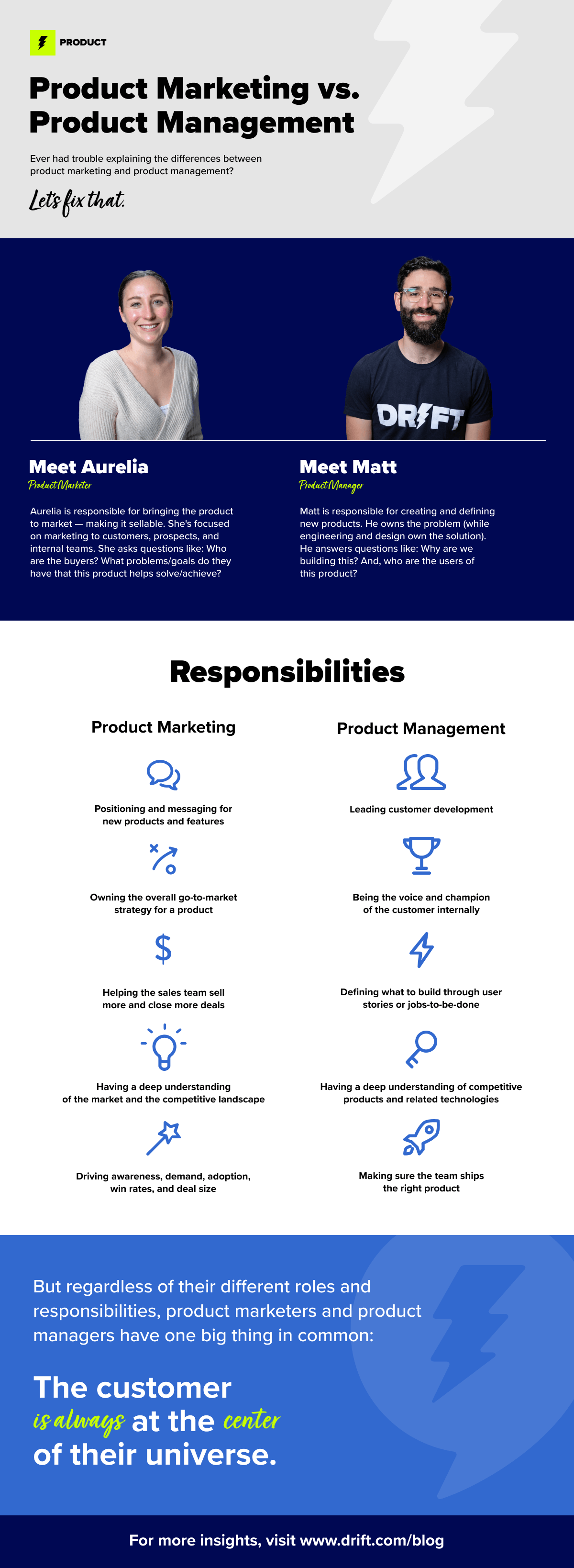I get the question all the time: “What’s the difference between product marketing and product management?” So, if you’re reading this thinking the same thing, don’t worry. You aren’t the only one.
Hey everyone, I’m Aurelia 👋 I’m the Director of Product Marketing at Drift, and I’m here to set the record straight.
A product manager helps create and define a new product. They own the problem. They answer questions like: Why are we building this? And, who are the users of this product?
Being a product manager is incredibly hard. It takes a lot of research, listening, testing, and patience to build an excellent product. (Kudos to all my partners in product management. My job wouldn’t exist without the awesome products you build.)
On the other hand, a product marketer is responsible for bringing the product to market — making it sellable. We’re focused on marketing to customers, prospects, and our internal teams. We ask questions like: Who are the buyers? What problems/goals do they have that this product helps solve/achieve?
So, is that it? Not exactly. There’s a good reason why people keep getting these roles mixed up — enough that I spoke on a podcast about it. If you want to listen to the full episode, here’s the link: The Ins and Outs of Product Marketing. Otherwise, keep reading for all the insights 💡
How Are Product Marketing & Product Management Similar?
Though our main responsibilities differ, product marketers and product managers share three things in common:
- The customer is always at the center of our universe.
- We work effectively across the entire organization, whether that’s with sales, customer success, product, or marketing.
- There is no one-size-fits-all description of either role — so, they often get muddled together.
Every company has its own unique approach to product marketing and product management. But just because both roles have the word “product” in their titles doesn’t mean their roles are interchangeable — not even close.
To put that into perspective, let me walk you through the details of what a product marketer does and our particular responsibilities at Drift.
What Are the Basics of Product Marketing?
What the role of a product marketer boils down to is being the voice of the customer.
Product marketers adopt an outside-in mentality, which means keeping up with our customers’ challenges and goals, as well as market trends and our competitors’ solutions. We then use those insights to help inform the product roadmap for future improvements.
Our closest stakeholders are the sales and product teams, but we also collaborate closely with customer success, marketing, and our executive team. Our roadmaps help these teams understand new products and features, which allows them to promote these developments to prospects or customers. This is crucial because it is those products that help us stand out against our competitors.
At heart, product marketers are storytellers. We know no one buys features and products. They buy solutions to their problems. That’s why we make sure everyone knows how to talk about and sell our products. There’s a lot that goes into that: from messaging and customer-facing content to go-to-market (GTM) enablement and mapping out the talking points in the sales conversation.
Measuring the impact of product marketing is tough. After all, a lot of our work is qualitative. But the easiest way to measure our success is through win rate and average selling price (ASP). In other words, is sales winning new buyers, and are customers adopting more of our products?
In short, a successful product marketer brings the customer and market point of view to the table and helps craft stories about products that solve customers’ needs to ensure that sales can successfully sell.
The 4 Main Pillars of Product Marketing
While the basics of product marketing remain largely the same across organizations, their priorities vary depending on the department they sit in.
In my career, I’ve seen product marketing from both the product and marketing side. Often, this leads to an imbalance between a focus on product and a focus on sales.
Deep down, I believe companies need a healthy split between the two. Product marketers need to have a good product and be able to sell it. We do this by focusing on four core pillars within product marketing:
1. Market Insights 📈
Part of knowing what buyers want is being knowledgeable about the market. Some of this is based on market research: How big is the total market for your product? Which companies fall within your target? Who are your competitors and how do you compare to them? And what are the macro trends in the industry?
But market insights also come from conversations with influencers, analysts, and (of course) customers and prospects. All of this information is a goldmine for product marketers to draw from in order to craft strategic messaging, inform product prioritization, and create roadmaps.
2. Product Positioning 👩💻
What makes you and your product stand out from the competition? Product positioning is all about knowing how to market and sell your products as a solution to a problem. To strike a chord with buyers, product marketers must clearly address customers’ pain points and highlight how their solution helps solve them, while also showing how their solution is better than those of their competitors.
At the same time, product marketers need to draw on their company philosophy and brand voice so that their product messaging is in tune with their company’s core values. That way, buyers won’t see your product as one solution among many but as the solution they need to solve their problems.
3. Go-to-Market 💰
This is all about strategizing your product launch. Go-to-market involves a range of things, including naming, pricing and packaging, goal setting, positioning, and marketing strategies. The most important thing to keep in mind is the “who.” You always want to refer back to the verticals and personas your solution is designed for. The key here is to use value-based language so that your customers won’t get lost in technical jargon.
4. Sales, Customer Success & Partner Enablement 🤝
Great, you’ve built your product! But your product isn’t going to sell itself. Product marketers should be prepared to teach sellers and customer success what the product is and coach them on how to talk about it. Because, at the end of the day, if the folks interacting with customers don’t get what the product is and why they should care about it, customers won’t adopt it.
To be successful, product marketers need to own these four pillars — from product prioritization to launch to sale. None of this is possible, though, without a solid relationship between product marketing and product management. This brings me to my next point 👇
Spend Time on the Relationship Between Product Marketing and Product Management
Product marketers and product managers need to be tied at the hip (figuratively speaking, of course). We need to gel even when the product is still in its planning stage.
Why?
Though the bulk of a product marketer’s work will come as the product is being built, the sooner we’re brought in the better. When product marketers are brought in early, we can start to study the product: why it’s being built, who it’s for, and what problem it’s solving. This gives us more time to build a compelling story for customers and plan a successful market launch.
We all know that product launches take a ton of time and coordination. Ensuring a successful launch means aligning early and often and having a watertight process from start to finish.
Think about the relationship between product marketing and product management like this: We’re a team, baking a cake together. Both teams need to work to add the right ingredients to the mix so, once the product is out of the oven, it’s restaurant quality and ready for all the sweet-toothed diners 🍰
So, remember: As long as you keep product marketing and product management aligned, you’ll be able to build great products that will sell like hotcakes.
Want to know more about the roles and responsibilities of product marketing vs. product management? Check out the infographic below 👇









